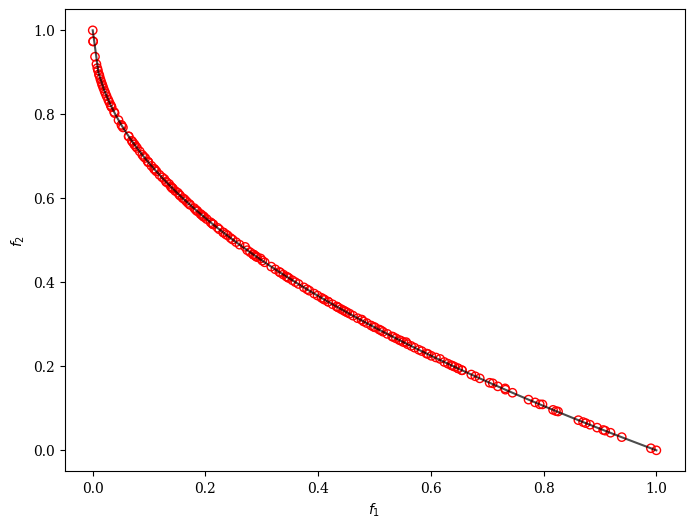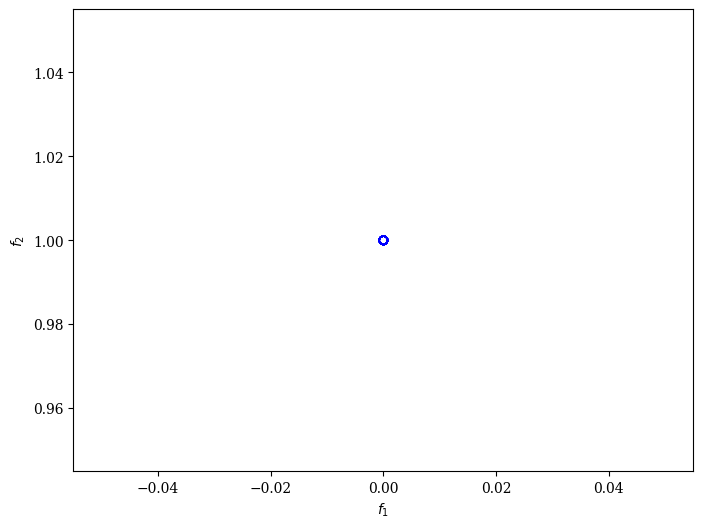MOPSO-CD: Multi-Objective Particle Swarm Optimization with Crowding Distance#
MOPSO-CD extends the traditional Particle Swarm Optimization (PSO) framework to handle multi-objective optimization problems through enhanced diversity mechanisms. The algorithm incorporates crowding distance-based leader selection and archive management to ensure a well-distributed Pareto front, making it particularly suitable for problems requiring good diversity preservation.
Key Features#
Crowding Distance-based Leader Selection: Uses crowding distance to select diverse leaders for particles, ensuring better exploration of the objective space.
External Archive Management: Maintains an external archive of non-dominated solutions with crowding distance-based pruning to preserve diversity.
Tournament Selection: Implements binary tournament selection with crowding distance to maintain diversity while keeping solution quality.
Enhanced Exploration: Increased inertia weight and velocity bounds for better exploration capabilities.
Algorithm Overview#
Initialization: Initialize population, velocities, and personal bests
Archive Management: Update external archive with non-dominated solutions using crowding distance pruning
Diverse Leader Selection: Select leaders for particles using crowding distance-based tournament selection
Velocity Update: Update velocities using cognitive and social components with selected leaders
Position Update: Update particle positions with velocity bounds
Personal Best Update: Update personal best solutions based on dominance
Archive Pruning: Maintain archive size using crowding distance-based selection
Example#
[1]:
from pymoo.algorithms.moo.mopso_cd import MOPSO_CD
from pymoo.problems import get_problem
from pymoo.optimize import minimize
from pymoo.visualization.scatter import Scatter
problem = get_problem("zdt1")
algorithm = MOPSO_CD(
pop_size=100,
w=0.6,
c1=2.0,
c2=2.0,
max_velocity_rate=0.5,
archive_size=200,
seed=1
)
res = minimize(problem,
algorithm,
('n_gen', 200),
seed=1,
verbose=False)
plot = Scatter()
plot.add(problem.pareto_front(), plot_type="line", color="black", alpha=0.7)
plot.add(res.F, facecolor="none", edgecolor="red")
plot.show()
[1]:
<pymoo.visualization.scatter.Scatter at 0x1075a3070>

Customization#
MOPSO-CD can be customized with different parameters to balance exploration and exploitation:
[2]:
from pymoo.algorithms.moo.mopso_cd import MOPSO_CD
from pymoo.problems import get_problem
from pymoo.optimize import minimize
from pymoo.visualization.scatter import Scatter
problem = get_problem("zdt2")
# Customized MOPSO-CD with different parameters
algorithm = MOPSO_CD(
pop_size=150, # Larger population for better diversity
w=0.729844, # Standard PSO inertia weight
c1=1.49618, # Cognitive parameter
c2=1.49618, # Social parameter
max_velocity_rate=0.2, # Lower velocity for more exploitation
archive_size=100, # Smaller archive for faster convergence
seed=1
)
res = minimize(problem,
algorithm,
('n_gen', 300),
seed=1,
verbose=False)
Scatter().add(res.F, facecolor="none", edgecolor="blue").show()
[2]:
<pymoo.visualization.scatter.Scatter at 0x1062d7be0>

Application to Multi-Objective Reinforcement Learning#
MOPSO-CD is particularly well-suited for multi-objective reinforcement learning problems like MO-HalfCheetah, where maintaining diversity in the objective space is crucial for finding a well-distributed set of trade-off solutions.
API#
- class pymoo.algorithms.moo.mopso_cd.MOPSO_CD(pop_size=100, w=0.6, c1=2.0, c2=2.0, max_velocity_rate=0.5, archive_size=200, sampling=<pymoo.operators.sampling.rnd.FloatRandomSampling object>, output=<pymoo.util.display.multi.MultiObjectiveOutput object>, **kwargs)[source]
Multi-Objective Particle Swarm Optimization with Crowding Distance (MOPSO-CD) algorithm.
This implementation extends MOPSO with a crowding distance mechanism for leader selection and archive management to ensure a well-distributed Pareto front, suitable for problems like MO-HalfCheetah in multi-objective reinforcement learning.
- Parameters:
- pop_sizeint
The population size (number of particles)
- wfloat
Inertia weight
- c1float
Cognitive parameter (personal best influence)
- c2float
Social parameter (global best influence)
- max_velocity_ratefloat
Maximum velocity rate relative to the variable range
- archive_sizeint
Maximum size of the external archive
- samplingSampling
Sampling strategy for initialization
- outputOutput
Output display
Algorithm Comparison#
MOPSO-CD differs from other multi-objective PSO variants in several key aspects:
Leader Selection: Uses crowding distance-based tournament selection instead of random selection
Archive Management: Implements sophisticated archive pruning using crowding distance
Exploration Focus: Higher inertia weight and velocity bounds for better exploration
Diversity Preservation: Enhanced mechanisms for maintaining solution diversity
References#
The algorithm is based on extensions of traditional MOPSO with crowding distance mechanisms for improved diversity preservation in multi-objective optimization problems.
Implementation#
This algorithm has been implemented by Rasa Khosrowshahi and extends traditional MOPSO with crowding distance mechanisms for leader selection and archive management. The implementation is particularly well-suited for multi-objective reinforcement learning problems where maintaining diversity in the objective space is crucial for finding well-distributed trade-off solutions.